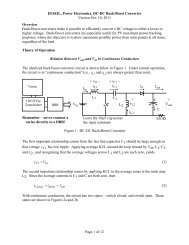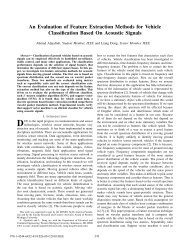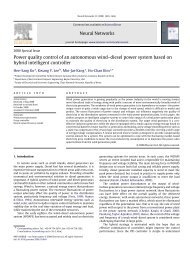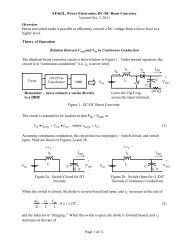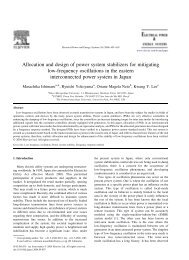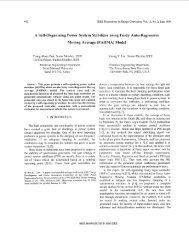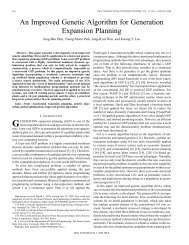1306 J.M. Davis et al. / J. Math. Anal. Appl. 332 (2007) 1291–1307the identity map, while in the functi<strong>on</strong> spaces this identity map maps g into f σ by the switchingof the exp<strong>on</strong>entials between the two domains.<str<strong>on</strong>g>The</str<strong>on</strong>g> preceding discussi<strong>on</strong> provides the basis for the uniqueness of the <str<strong>on</strong>g>transform</str<strong>on</strong>g> of the deltafuncti<strong>on</strong>al. Through the diagram we see that if another functi<strong>on</strong>al had the same <str<strong>on</strong>g>transform</str<strong>on</strong>g>, thenthere would be two such functi<strong>on</strong>als over Cc ∞ (R, R) which had the same <str<strong>on</strong>g>transform</str<strong>on</strong>g>, which weknow to be false.Next, we examine more properties of the Dirac delta. We have already noted that the functi<strong>on</strong>alhas <str<strong>on</strong>g>transform</str<strong>on</strong>g> 1 (as desired) since 〈δ 0 ,e⊖z σ (t, 0)〉=1. Sec<strong>on</strong>d, the <str<strong>on</strong>g>transform</str<strong>on</strong>g> of the derivative ofthe delta functi<strong>on</strong>al is familiar:L { ∫∞δ0 }= δ0 eσ ⊖z (t, 0)t0= δ 0 e ⊖z (t, 0) ∣ ∫∞∞ t=0 − ⊖ze ⊖z (t, 0)δ 0 t= z∫ ∞0= zL{δ 0 }= z,e σ ⊖z (t, 0)δ 0 t0so that L{δ0 } is the same as it <strong>on</strong> R.Finally, just as <strong>on</strong> R, the derivative of the Heaviside functi<strong>on</strong> is still the Dirac delta:〈H ,g σ 〉 =∫ ∞0H (t)g σ (t) t= H(t)g(t) ∣ ∫∞∞ t=0 − H(t)g (t) t=−∫ ∞0= g(0)= 〈 δ 0 ,g σ 〉 .g (t) t4. Applicati<strong>on</strong>s to Green’s functi<strong>on</strong> analysis0We now dem<strong>on</strong>strate a powerful use of the Dirac delta as applied to the Green’s functi<strong>on</strong>analysis that is ubiquitous in the study of boundary value problems.C<strong>on</strong>sider the operator L : S → C rd given byLx(t) = ( px ) (t) + q(t)x σ (t),where p,q ∈ C rd , p(t) ≠ 0 for all t ∈ T, and S ={x ∈ C 1 (T, R): (px ) ∈ C rd (T, R)}.
J.M. Davis et al. / J. Math. Anal. Appl. 332 (2007) 1291–1307 1307In Bohner and Peters<strong>on</strong> [2], it is shown that if the homogeneous boundary value problemLx = 0, αx(a)− βx (a) = γx ( σ 2 (b) ) + δx ( σ(b) ) = 0,has <strong>on</strong>ly the trivial soluti<strong>on</strong>, then the n<strong>on</strong>homogeneous boundary value problemLx = h ( σ(t) ) , αx(a)− βx (a) = A, γ ( σ 2 (b) ) + δx ( σ(b) ) = B,where h σ ∈ C rd , and A and B are given c<strong>on</strong>stants, has a unique soluti<strong>on</strong>. If φ is the soluti<strong>on</strong> ofLφ = 0, φ(a)= β, φ (a) = α,and ψ is the soluti<strong>on</strong> ofLψ = 0, ψ ( σ 2 (b) ) = δ, ψ ( σ(b) ) =−γ,then the soluti<strong>on</strong> of the n<strong>on</strong>homogeneous problem above can be written in the form∫x(t) =σ(b)aG ( t,σ(s) ) h ( σ(s) ) s,where G(t, σ (s)) is the Green’s functi<strong>on</strong> for the boundary value problem and is given byG ( t,σ(s) ) { 1cφ(t)ψ(σ (s)), if t s,=1cψ(t)φ(σ (s)), if t σ(s),where c := p(t)W (φ, ψ)(t) is a c<strong>on</strong>stant. <str<strong>on</strong>g>The</str<strong>on</strong>g>y further show that the Green’s functi<strong>on</strong> is symmetric.For any s ∈[a,σ(b)], if h(σ (t)) = δ σ(t) (s), then∫x(t) =σ(b)aand therefore,L ( G ( t,σ(s) )) = δ σ(t) (s).In fact,∫Lx =Referencesσ(b)aδ σ(s) (s)G ( t,σ(s) ) s = G ( t,σ(s) ) ,L ( G ( t,σ(s) )) h ( σ(s) ) ∫s =σ(b)aδ σ(t) (s)h ( σ(s) ) s = h ( σ(t) ) .[1] L. Berg, Introducti<strong>on</strong> to the Operati<strong>on</strong>al Calculus, John Wiley & S<strong>on</strong>s, New York, 1967.[2] M. Bohner, A. Peters<strong>on</strong>, Dynamic Equati<strong>on</strong>s <strong>on</strong> Time Scales: An Introducti<strong>on</strong> with Applicati<strong>on</strong>s, Birkhäuser, Bost<strong>on</strong>,2001.[3] M. Bohner, A. Peters<strong>on</strong>, <str<strong>on</strong>g>Laplace</str<strong>on</strong>g> <str<strong>on</strong>g>transform</str<strong>on</strong>g> and Z-<str<strong>on</strong>g>transform</str<strong>on</strong>g>: Unificati<strong>on</strong> and extensi<strong>on</strong>, Methods Appl. Anal. 9 (1)(2002) 155–162.[4] T. Gard, J. Hoffacker, Asymptotic behavior of natural growth <strong>on</strong> <strong>time</strong> <strong>scales</strong>, Dynam. Systems Appl. 12 (1–2) (2003)131–148.[5] G. Guseinov, Integrati<strong>on</strong> <strong>on</strong> <strong>time</strong> <strong>scales</strong>, J. Math. Anal. Appl. 285 (2003) 107–127.[6] C. Pötzsche, S. Siegmund, F. Wirth, A spectral characterizati<strong>on</strong> of exp<strong>on</strong>ential stability for linear <strong>time</strong>-invariantsystems <strong>on</strong> <strong>time</strong> <strong>scales</strong>, Discrete C<strong>on</strong>tin. Dyn. Syst. 9 (5) (2003) 1223–1241.







